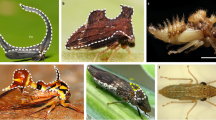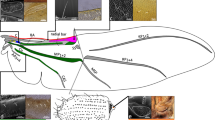We report here our studies of the characteristics of the structural-functional organization of the leg apparatus of the dragonfly Aeshna grandis, in larvae of the final instar, whose legs have a locomotor function, and in adult winged individuals (imagoes), whose legs have lost their locomotor function and are used mainly as traps to catch prey in the air. Neither the shape nor the proportions of individual leg segments in imagoes were significantly different from those in larvae, and all changes in the functional role of the legs in imagoes occur as a result of changes in the mechanisms controlling the functioning of the leg muscles and the corresponding rearrangements in coordinatory relationships. These rearrangements, as evidenced by the data reported here, affect the mechanisms generating motor commands, the appearance of a tight correlation in the operation of the wing muscles and the leg apparatus, and various others. These mechanisms are discussed.
Similar content being viewed by others
References
A. A. Zavarzin, Characteristics of the Evolutionary Histology of the Nervous System, Medgiz, Moscow, Leningrad (1941).
S. I. Plotnikova and I. L. Isavnina, “Olfaction in the dragonfly Aeschna grandis,” Zh. Evolyuts. Biokhim. Fiziol., 48, No. 5, 515–516 (2012).
S. I. Plotnikova, V. L. Siderskii, and V. S. Gorelkin, “Characteristics of the structural-functional organization of the motor neuropil of the thoracic ganglia in dragonflies,” Zh. Evolyuts. Biokhim. Fiziol., 48, No. 5, 509–514 (2012).
V. L. Siderskii and S. I. Plotnikova, “The structural-functional organization of the mushroom bodies of dragonflies and some general conclusions on the purposes of these formations,” Zh. Evolyuts. Biokhim. Fiziol., 40, No. 6, 495–507 (2004).
V. L. Siderskii, S. I. Plotnikova, and V. S. Gorelkin, “Structural-functional characteristics of the wing apparatus of insects with and without manoeuver flight,” Zh. Evolyuts. Biokhim. Fiziol., 44, No. 6, 545–555 (2008).
V. L. Siderskii, V. S. Gorelkin, S. I. Plotnikova, and I. Yu. Severina, “The flight of dragonflies: leg function and the problem of flight inhibition,” Zh. Evolyuts. Biokhim. Fiziol., 45, No. 5, 524–526 (2009).
V. L. Siderskii, S. I. Plotnikova, and V. L. Gorelkin, “The mechanisms supporting fast motor reactions in dragonflies in flight,” Zh. Evolyuts. Biokhim. Fiziol., 46, No. 5, 440–441 (2010).
U. Bässler, “Interaction of central and peripheral mechanisms during walking in the first instar stick insects, Extatosoma tiaratum,” Physiol. Entomol., 4, 193–199 (1979).
F. Delcomyn, “The locomotion of the cockroach, Periplaneta americana,” J. Exp. Biol., 54, 443–445 (1971).
G. Fraenkel, “Untersuchungen über die Koordination von Reflexen und automatische-nervösen Rhythmen bei Insekten. I. Die Flugreflexe der Insekten und ihre Koordination,” Ztschr. Vergl. Physiol., 16, 371–393 (1932).
L. Frantsevich and W. Wang, “Gimbals in the insect leg,” Arthropod Structure Dev., 38, 16–30 (2009).
K. G. Leipelt, F. Suhling, and S. N. Gorb, “Ontogenetic shifts in functional morphology of dragonfly legs (Odonata: Anisoptera),” Zoology, 113, 317–325 (2010).
R. M. Olberg, A. H. Worthington, A. H. Fox, et al., “Prey size selection and distance estimation in foraging adult dragonflies,” J. Comp. Physiol., A191, 791–797 (2005).
R. M. Olberg, “Visual control of prey-capture flight in dragonflies,” Curr. Opin. Neurobiol., 22, 1–5 (2011).
K. G. Pearson and J. F. interleukins, “Discharge patterns of coxal levator and depressor motoneurones of the cockroach, Periplaneta americana,” J. Exp. Biol., 52, 139–165 (1970).
K. G. Pearson and J. F. Iles, “Innervation of coxal depressor muscles in the cockroach, Periplaneta americana,” J. Exp. Biol., 54, 215–232 (1971).
T. E. Sherk, “Development of the compound eyes of dragonflies (Odonata). II. Development of the larval compound eyes,” J. Exp. Zool., 203, 47–60 (1978).
T. E. Sherk, “Development of the compound eyes of dragonflies (Odonata). III. Adult compound eyes,” J. Exp. Zool., 203, 61–80 (1978).
R. J. Tillyard, The Biology of Dragonflies, Cambridge University Press, Cambridge (1917).
T. Weis-Fogh, “Biology and physics of locust flight. IV. Notes on sensory mechanisms, in locust flight,” Phil. Trans. Roy. Soc., B239, 553–584 (1956).
Author information
Authors and Affiliations
Corresponding author
Additional information
Translated from Rossiiskii Fiziologicheskii Zhurnal imeni I. M. Sechenova, Vol. 98, No. 11, pp. 1432–1440, November, 2012.
Rights and permissions
About this article
Cite this article
Sviderskii, V.L., Plotnikova, S.I., Gorelkin, V.S. et al. Functional Role of Dragonfly Legs before and after Wing Formation: Rearrangement of Coordinatory Relationships. Neurosci Behav Physi 44, 804–809 (2014). https://doi.org/10.1007/s11055-014-9987-1
Received:
Published:
Issue Date:
DOI: https://doi.org/10.1007/s11055-014-9987-1




